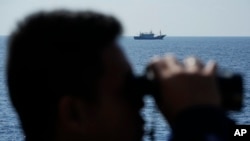The United States and the Philippines this week added new guidelines to a 1951 defense treaty that detail how the U.S. will respond to an attack on the Philippines in the South China Sea.
Following a visit by Philippine President Ferdinand Marcos to the White House, the U.S. issued the guidelines saying its commitment to defend Manila will apply to the maritime region, where Manila has complained for years about territorial incursions by Chinese ships.
Any attack in the South China Sea on Philippine public vessels, aircraft or armed forces — which includes the coast guard — will invoke mutual defense commitments.
The guidelines also say the two countries will "coordinate closely on the Philippines' defense modernization,” including a review to determine what equipment the country needs “that will bolster combined deterrence and capacity to resist coercion."
The guidelines recognize that threats may arise in several domains and take the form of asymmetric, hybrid and irregular warfare and gray-zone tactics like using non-naval vessels such as fishing boats as an informal maritime militia.
China was not named in the guidelines, but it has been long criticized for using gray-zone tactics to claim sovereignty in the South China Sea.
Beijing’s Foreign Ministry responded by saying China firmly opposes any country's move to interfere in the South China Sea issue to harm China's territorial sovereignty and maritime rights and interests.
"The South China Sea is home to all regional countries and should not be a hunting ground for external forces," ministry spokesperson Mao Ning told a regular briefing.
US-Philippine state visit
U.S. President Joe Biden told Marcos on Monday, "The United States remains ironclad in our commitment to the defense of the Philippines, including the South China Sea."
Brian Harding, a senior expert at the U.S. Institute of Peace, told VOA in an email, "It's significant that Biden is using such clear language. The fact that the two leaders are clearly in sync makes the commitments far more concrete than during [Rodrigo] Duterte's presidency."
Duterte made a point of shifting his country’s foreign policy away from Washington when he took office in 2016, but his efforts to move closer to Beijing did little to stop China’s maritime territorial incursions. Duterte later moved to shore up security ties with Washington before the end of his term.
Gregory B. Poling, director of the Southeast Asia Program and Asia Maritime Transparency Initiative at the Center for Strategic and International Studies, told VOA the new guidelines provide more clarity about U.S. responses in the region.
"It doesn't mean that if there's a run-in between a Chinese coast guard [vessel] and the Philippine coast guard vessel, we automatically start World War III. But if the Philippines calls on American aid under the Mutual Defense Treaty, the United States will answer."
Beijing claims sovereignty over almost the entire South China Sea on the basis of historic Chinese maps, ignoring an international ruling that the assertion has no legal basis.
The most recent faceoff occurred on April 23, when a Philippine coast guard vessel patrolling near Second Thomas Shoal nearly collided with a Chinese coast guard vessel at a close range of only about 45 meters.
